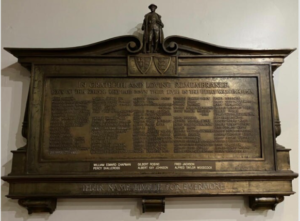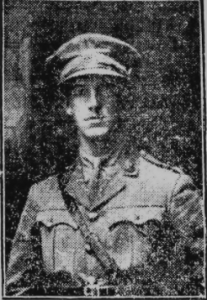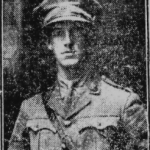
BORN HULL 1895. YOUNGEST SON OF LATE GILDING COOPER & ANNIE ELIZABETH COOPER,OF 350 BEVERLEY ROAD, HULL. HIS FATHER WAS A CHIEF BALLIFF. A SINGLE MAN. EDUCATED AT HULL GRAMMAR SCHOOL. HE WORKED AS A JUNIOR ASSISTANT IN THE CLERK’S DEPARTMENT, HUMBER CONVEYANCY BOARD.

HE ENLISTED IN THE “HULL COMMERCIALS” WHEN WAR BEGAN. SERVED WITH THE 10TH EAST YORKSHIRE REGIMENT, IN EGYPT AND FRANCE. PROMOTED TO LANCE CORPORAL AND RETURNED TO ENGLAND TO RECEIVE HIS COMMISSION IN JULY 1917. HE RETURNED TO FRANCE IN AUGUST 1917 AND TRANSFERRED TO THE 7TH EAST YORKSHIRE BATTALION. HE WAS KILLED IN ACTION, ON 31/03/1918, AGED 23. COMMEMORATED ON THE ARRAS MEMORIAL, FRANCE. HIS DEATH WAS REPORTED IN THE HULL DAILY MAIL, ON 12/04/1918. *
THIS WAS HIS PROBATE ADDRESS. HE LEFT £107 IN HIS WILL, TO HIS BROTHER, WILLIAM BURTON COOPER, SOLICITOR, MANOR STREET, HULL. HIS NAME IS RECORDED ON THE HULL GRAMMAR SCHOOL WW1 MEMORIAL & ST JOHNS NEWLAND CHURCH MEMORIAL, HULL
Background – The German Offensive of Spring 1918 called the Kaiserschlacht, aimed to break through the Allied defences and swing round behind them to cut off supplies and hopefully change the course of the war. On 31st March 1918 the 7th East Yorkshires attacked the enemy under the following circumstances: the 50th Brigade was then holding Bouzincourt, with the 2nd Division on its left: the 7th Battalion was in front (east) of the village. On the night of 28th the 10th West Yorkshires had been ordered to occupy and dig posts along the Bouzincourt-Aveluy road, about half-way between the two villages: the ground about here was high, offering good observation over Albert, which still remained in the hands of the enemy. The West Yorkshires carried out their orders and dug the posts, reporting at 6 a.m. on 29th that all was quiet, but in the evening, at about 7 p.m., the enemy rushed the posts and gained possession of them, the West Yorkshires suffering some fifteen casualties. A little later the Germans attempted to rush the Lewis-gun posts at the cross-roads but were driven off, though they dug in west of the road. On 30th March 1918 (at 3.45 a.m.), the enemy was reported to be holding the high ground just east of the captured posts in strength, and the 7th East Yorkshires were ordered to turn them out and recapture the lost posts. Zero hour for the attack was to be 5.30 a.m. on 31st. Four light tanks and the artillery were to co-operate and 12 Lewis guns from the Tank Corps were sent to strengthen the line.
In a heavy rain the East Yorkshires moved forward to the attack and reached their objective: they were subjected to heavy machine-gun fire from the Briquetiere and buildings near Albert as well as from behind the posts. Nevertheless, they gained their objective. The tanks were not much use: one failed to start owing to engine trouble, the Hotchkiss gun of another jammed, and one of the remaining two was damaged and had to be temporarily abandoned. The East Yorkshires gallantly held on to the recaptured ground for some time, but the troops on either flank were held up and finally the 7th Battalion was compelled to fall back to its original line. At nightfall they were relieved by troops of 52nd Brigade and moved back to billets in Henencourt, arriving at 1 a.m. on 1st April. The 7th East Yorkshire’s casualties were 19 Officers and 400 Other Ranks.
